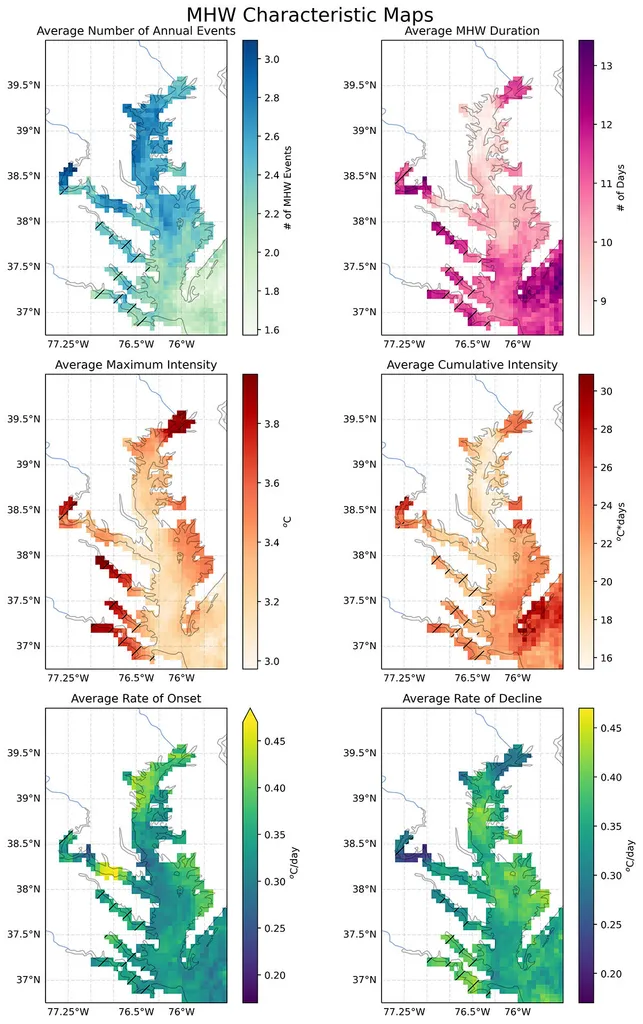- May 23, 2025
- By Emily C. Nunez
Heat waves destroy crops, drive wildfires and kill people and wildlife, but they aren’t just limited to land. Large bodies of water are also hit by these extreme weather events that linger for weeks, months and sometimes years—much like “The Blob,” a sprawling hot spot that wreaked havoc on ecosystems off the U.S. West Coast from 2013 to 2016.
New University of Maryland-led research reveals that the Chesapeake Bay has seen “significant increases” in annual marine heat waves, defined in the study as “prolonged periods of anomalously warm water.” Published Thursday in the journal Estuaries and Coasts, the study leveraged long-term satellite observations to map out heat waves over 20 years.
The study, funded by the National Oceanic and Atmospheric Administration (NOAA) and the National Science Foundation, could help lay the groundwork for a warning system for excessive heat in the bay that experts said is needed to protect agriculture and aquaculture, recreation and other important activities.
It showed that, on average, the Chesapeake Bay experiences heat waves 25 days annually. From 2003 to 2022, the bay had a roughly 10% uptick in annual marine heat waves, translating to two to four additional marine heat waves per decade.
“It sounds small, but a little bit goes a long way in the climate system,” said study lead author Rachel Wegener M.S. ’23,, who conducted this research as part of her master’s thesis in atmospheric and oceanic science at UMD.

Wegener explained that each additional heat wave can have an outsize effect on the Chesapeake, one of the largest and most biologically productive estuaries in the U.S. Some marine species are sensitive to high temperatures, which can affect their reproduction and distribution.
“One additional marine heat wave at the wrong time in the spring might throw off recruitment of new fish to a population, affecting species numbers for the rest of the year,” she said. “Striped bass, a common recreational and commercial fishing species, typically spawn in the Chesapeake Bay and its tributaries. Spawning goes down if the water temperatures are too high.”
Wegener took the lead on this research following the graduation of co-author Skylar Lama ’22, who initiated the study for her undergraduate capstone project in atmospheric and oceanic science. Additional co-authors include Jacob Wenegrat, an assistant professor of atmospheric and oceanic science at UMD and Veronica Lance, a NOAA oceanographer.
While analyzing three satellite datasets from NASA, NOAA and the European Union Space Programme, the research team made a novel discovery: The duration and frequency of Chesapeake heat waves vary greatly by latitude. The lower portion—an area covering 1,500 square miles south of the Potomac River—experiences fewer individual heat waves, but these events tend to last longer. The upper bay, on the other hand, has more frequent but shorter heat waves.
“These two regions of the bay look like they have the same number of heat wave days per year, but the different underlying patterns might have different implications—not just for the mechanisms driving them, but also their effect on the ecosystem,” Wenegrat said.
While researchers identified significant differences between marine heat waves in different parts of the bay, the reason for this variation remains a mystery.
When the researchers first started exploring this issue, they wanted to determine whether satellite data could offer a more complete picture of where heat waves occur. Previous studies relied on data collected by buoys and boats, which revealed heat wave trends over time but did not show how much they varied from one location to the next.
Earlier research may have been limited by the difficulty of collecting on-site data from the bay’s harder-to-reach tributaries, according to Wenegrat.
“One of the major outcomes of this study is that it serves as a proof of concept that you can use satellite data in this way,” he said. “It pushes the boundary of satellite resolution for sea surface temperature into these relatively thin estuary settings and suggests it’s possible to study and monitor other locations that are not as well-observed.”
Understanding how and where these heat waves occur—and the unique threats they pose—can help those who manage the bay and its many resources. In a 2023 report, the Chesapeake Bay Program’s Scientific and Technical Advisory Committee identified a need for a marine heat wave warning system. Wegener explained that satellite data is a “prime candidate” for forming the basis of this system.
Beyond shedding light on marine heat waves, Wegener said the new study is another example of how publicly funded satellite data can benefit society.
“There is a huge amount of social and economic benefit in this data that goes far beyond the temperature of water,” Wegener said. “Publicly funded, openly available data touches our hobbies, our safety and our livelihoods. It’s not always immediately visible, but we are benefitting from NOAA and NASA satellite data every day.”
